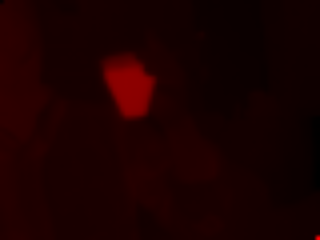FLiR Dev Kit を試す その4
画像を表示するだけなら今のままでも良いのですが、温度の算出をしたいので、Output frame に触れましょう。
触れたあとに、加工して、最後には画像にしたい、、、ので、Python + Opencv がお手軽ではないかと思っていたところ、素敵なサンプルコードを発見しました。
Python から キャプチャするコード
GitHub - groupgets/pylepton: Quick and dirty pure python library for interfacing with FLIR lepton
サンプルコード
import numpy as np import cv2 from pylepton import Lepton with Lepton() as l: a,_ = l.capture() cv2.normalize(a, a, 0, 65535, cv2.NORM_MINMAX) # extend contrast np.right_shift(a, 8, a) # fit data into 8 bits cv2.imwrite("output.jpg", np.uint8(a)) # write it!
Lepton() で何が手に入って、Lepton.capture() で何が返ってくるのかを見ましょう。
def capture(self, data_buffer = None, log_time = False, debug_print = False, retry_reset = True): """Capture a frame of data. Captures 80x60 uint16 array of non-normalized (raw 12-bit) data. Returns that frame and a frame_id (which is currently just the sum of all pixels). The Lepton will return multiple, identical frames at a rate of up to ~27 Hz, with unique frames at only ~9 Hz, so the frame_id can help you from doing additional work processing duplicate frames. Args: data_buffer (numpy.ndarray): Optional. If specified, should be ``(60,80,1)`` with `dtype`=``numpy.uint16``. Returns: tuple consisting of (data_buffer, frame_id) """
読みやすく改変
001.py
#!/usr/bin/env python # -*- coding: utf-8 -* import sys import copy import numpy as np import cv2 from pylepton import Lepton def main(): with Lepton() as l: data_buffer, frame_id = l.capture() print("---data_buffer---") print(data_buffer[59:, 75:]) print(data_buffer.shape) print(type(data_buffer)) data_1d = data_buffer.ravel() print( 'MAX:%d, MIN:%d' % (np.max(data_1d), np.min(data_1d) )) # 変数のコピー data_8bit = copy.deepcopy(data_buffer) data_normalized = copy.deepcopy(data_buffer) # data_normalized を正規化 cv2.normalize(data_buffer, data_normalized, 0, 65535, cv2.NORM_MINMAX) # extend contrast # fit to 8 bit np.right_shift(data_8bit, 8, data_8bit) np.right_shift(data_normalized, 8, data_normalized) print("----data_8bit----") print(data_8bit[59:, 75:]) print(data_8bit.shape) data_1d = data_8bit.ravel() print( 'MAX:%d, MIN:%d' % (np.max(data_1d), np.min(data_1d) )) print("---data_normalized---") print(data_normalized[59:, 75:]) print(data_normalized.shape) data_1d = data_normalized.ravel() print( 'MAX:%d, MIN:%d' % (np.max(data_1d), np.min(data_1d) )) image_original = np.uint8(data_8bit) image_gray = np.uint8(data_normalized) image_rgb = cv2.cvtColor(image_gray, cv2.COLOR_GRAY2BGR) image_org_rgb = cv2.cvtColor(image_original, cv2.COLOR_GRAY2BGR) image_rgb[:, :, 0:2] = 0 image_org_rgb[:, :, 0:2] = 0 print("---image_rgb---") print(image_rgb[59:, 75:]) print(image_rgb.shape) print("---image_org_rgb---") print(image_org_rgb[59:, 75:]) print(image_org_rgb.shape) # リサイズ image_original = cv2.resize(image_original, None, fx=4, fy=4) image_gray = cv2.resize(image_gray, None, fx=4, fy=4) image_rgb = cv2.resize(image_rgb, None, fx=4, fy=4) image_org_rgb = cv2.resize(image_org_rgb, None, fx=4, fy=4) cv2.imshow("Leption original", image_original) cv2.imshow("Leption normalize", image_gray) cv2.imshow("Leption RGB", image_rgb) cv2.imshow("Leption org RGB", image_org_rgb) cv2.waitKey(0) cv2.destroyAllWindows() if __name__ == '__main__': main()
やってみる。
$ ./001.py ---data_buffer--- [[[7915] [7916] [7919] [7908] [7904]]] (60, 80, 1) <type 'numpy.ndarray'> MAX:8327, MIN:7671 ----data_8bit---- [[[30] [30] [30] [30] [30]]] (60, 80, 1) MAX:32, MIN:29 ---data_normalized--- [[[95] [95] [96] [92] [90]]] (60, 80, 1) MAX:255, MIN:0 ---image_rgb--- [[[ 0 0 95] [ 0 0 95] [ 0 0 96] [ 0 0 92] [ 0 0 90]]] (60, 80, 3) ---image_org_rgb--- [[[ 0 0 30] [ 0 0 30] [ 0 0 30] [ 0 0 30] [ 0 0 30]]] (60, 80, 3)




たとえば、 output frame は 7904 でした。
0.026 * ( 7903 - 8192 ) + カメラの温度 = -7.488度 + カメラの温度
ってことかな?
正規化しないと、最小値が29で、最大値が32 なので、画像とはなりえない。ほぼ一色。
どこかのフォーラムにも書いてあったけど、範囲を決めて(摂氏 -20 ~ +100度など?)、その範囲外は 0 と 255 とみなして、120度の中範囲で 255 を使用したほうが良いかもしれない。
-20度 と +100度 における正規化 かな?
そうすれば、画像として見られたものに成って、かつ、出番の多そうな温度も拾える、、、かな?
やってみないとわからない。
-10度 +80度 を入れてみる
やってみた
強引ですが、output buffer を書き換えて、常に -10 と +80 が登場するようにして、それを 0~255 で正規化してみました。
左上の白と右上の黒が、それです。
#!/usr/bin/env python # -*- coding: utf-8 -* import sys import copy import numpy as np import cv2 from pylepton import Lepton def main(): with Lepton() as l: data_buffer, frame_id = l.capture() print("---data_buffer---") print(data_buffer[59:, 75:]) print(data_buffer.shape) print(type(data_buffer)) data_1d = data_buffer.ravel() print( 'MAX:%d, MIN:%d' % (np.max(data_1d), np.min(data_1d) )) # 変数のコピー data_8bit = copy.deepcopy(data_buffer) data_normalized = copy.deepcopy(data_buffer) # -10 +80 で上書き:基準値は 8192 data_8bit[0,0,0] = 7807 # -10度 data_8bit[59,79,0] = 11268 # +80度 # 正規化 cv2.normalize(data_8bit, data_8bit, 0, 255, cv2.NORM_MINMAX) # extend contrast cv2.normalize(data_normalized, data_normalized, 0, 255, cv2.NORM_MINMAX) # extend contrast print("----data_8bit----") print(data_8bit[59:, 75:]) print(data_8bit.shape) data_1d = data_8bit.ravel() print( 'MAX:%d, MIN:%d' % (np.max(data_1d), np.min(data_1d) )) print("---data_normalized---") print(data_normalized[59:, 75:]) print(data_normalized.shape) data_1d = data_normalized.ravel() print( 'MAX:%d, MIN:%d' % (np.max(data_1d), np.min(data_1d) )) image_original = np.uint8(data_8bit) image_gray = np.uint8(data_normalized) image_bgr = cv2.cvtColor(image_gray, cv2.COLOR_GRAY2BGR) image_org_bgr = cv2.cvtColor(image_original, cv2.COLOR_GRAY2BGR) image_bgr[:, :, 0:2] = 0 image_org_bgr[:, :, 0:2] = 0 print("---image_bgr---") print(image_bgr[59:, 75:]) print(image_bgr.shape) print("---image_org_bgr---") print(image_org_bgr[59:, 75:]) print(image_org_bgr.shape) # リサイズ image_original = cv2.resize(image_original, None, fx=4, fy=4) image_gray = cv2.resize(image_gray, None, fx=4, fy=4) image_bgr = cv2.resize(image_bgr, None, fx=4, fy=4) image_org_bgr = cv2.resize(image_org_bgr, None, fx=4, fy=4) cv2.imshow("Leption original", image_original) cv2.imshow("Leption normalize", image_gray) cv2.imshow("Leption RGB", image_bgr) cv2.imshow("Leption org RGB", image_org_bgr) # 保存 cv2.imwrite("001.image_original.png", image_original) cv2.imwrite("001.image_gray.png", image_gray) cv2.imwrite("001.image_bgr.png", image_bgr) cv2.imwrite("001.image_org_bgr.png", image_org_bgr) cv2.waitKey(0) cv2.destroyAllWindows() if __name__ == '__main__': main()
最初から 255 で正規化しました。


この2つの画像では、真っ赤(右下)なら、カメラより+80度高く、真っ黒(左上)なら、カメラより10度低い事になります。
映像としては、面白みが無い。
熱湯が入ったカップを持って、撮影してみました。
室温は20度なので、おそらくカメラも20度前後。
お湯は電気ポットから出したばかりです。


Output buffer の最大値は 9664 だった。おそらくこれはコップ。
0.026 * (9664 - 8192) = 38.272
室温の20を足すと、 だいたい60度?
こうなってきたら、もうちょっと正確に温度を用意して、キャリブレーション(傾きを算出)してみたくもなる。
でも、正確に温度のわかっている物体って、どこにあるのだろか。
修正
cv2.COLOR_GRAY2RGB を指定しても、出力が BGR に成っていたので、 cv2.COLOR_GRAY2BGR に直しました。